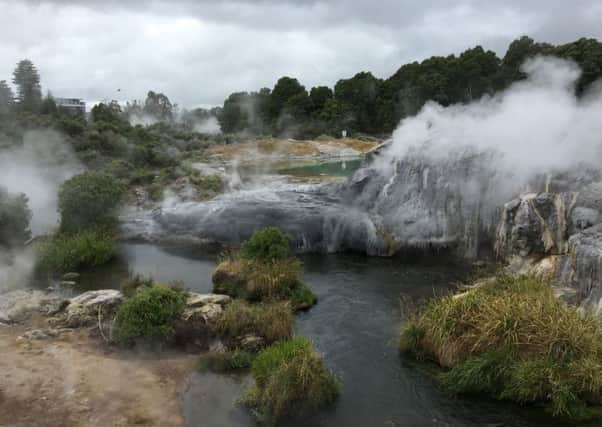Harrogate woman discovers '˜home from home' on the other side of the world


In the heart of New Zealand is a very real and very perfect English Spa town, writes Helen Barclay.
Elegant buildings rub shoulders with colourful public gardens all laid out along broad streets which lead to prosperous shops and high quality eateries … sound familiar? This is Rotorua.
Advertisement
Hide AdAdvertisement
Hide AdWith the fashion for ‘taking the waters’ which led to Harrogate’s Turkish Bath opening in 1897, it was only a matter of time before the New Zealanders realised the wonderful resource they had on their own door step.
Rotorua’s Bath House opened in 1908 and represented New Zealand’s first health and tourism investment; and a spectacular one it is too.
The huge Elizabethan- style building stands in Government Gardens, and sunshine aside, this compares favourably with Harrogate’s Valley Gardens (within which there is a mini ‘New Zealand’ garden).
Like at Harrogate, the waters of Rotorua were used in the treatment of gout and rheumatism.
Advertisement
Hide AdAdvertisement
Hide AdThe healing power of Harrogate’s water was apparently discovered some 400 years ago but the date when Rotorua’s health benefits were established cannot be told. The Maori tradition is verbal and no dates are recorded.
The water from both spa towns had similar benefits and many of the treatments and therapies used were available in both.
The Plombière douche and the Schnee (electric hydrotherapy) bath complemented the popular saline sulphur water.
Amusingly, Rotorua’s original Bath House structure was not complete when it opened in 1908, and it was only when the Centennial Restoration took place in 2008 that the symmetrical facade originally intended was finally completed.
Advertisement
Hide AdAdvertisement
Hide AdInside, the majority of the fittings were taken out when the baths closed in 1966, but enough remain to house a decent sized exhibition.
The comparison continues when you realise that Harrogate’s treatment centre closed in 1969. On the outskirts of Rotorua the similarities stop.
The thinness of the earth’s crust that puts the ‘thermal’ into Rotorua’s thermal springs is absent from Harrogate. The hot streams and boiling mud pools created by geothermal activity help the town to maintain its tourist population.
As Harrogate invested in exhibition centres and conference facilities, Rotorua invested in tourist exhibitions illustrating the history of the traditional Maori tribes drawn to the area by the benefits of nature’s cooking cauldrons, underfloor heating and hot bathing.
Advertisement
Hide AdAdvertisement
Hide AdTheir themed attractions are set in a backdrop of fabulous scenery with colourful mineral pools and spouting geysers – akin to but not resembling the gorgeous scenery of the Yorkshire Dales which gives Harrogate its stunning setting.